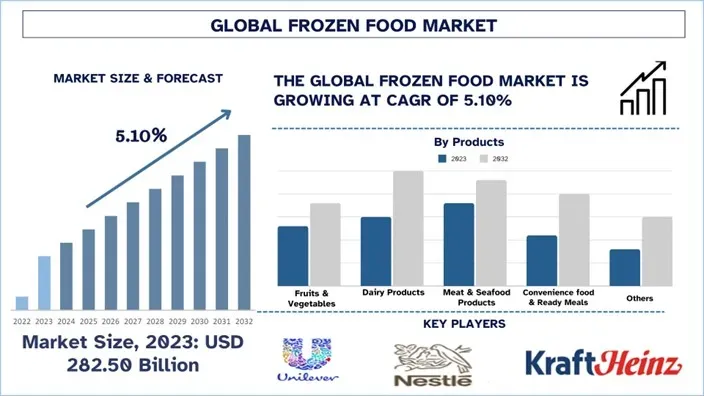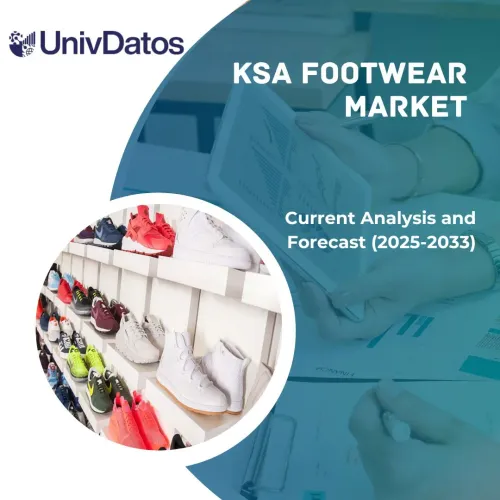- Home
- Chi siamo
- Settore
- Servizi
- Lettura
- Contattaci
Mercato degli alimenti surgelati: analisi e previsioni attuali (2024-2032)
Enfasi su prodotti (frutta e verdura, latticini, prodotti a base di carne e pesce, alimenti pronti e pasti pronti e altri); Consumo (servizio di ristorazione e vendita al dettaglio); Canale di distribuzione (offline e online); e Regione/Paese

Dimensioni e previsioni del mercato degli alimenti surgelati
Il mercato degli alimenti surgelati è stato valutato a USD 282,50 miliardi nel 2023 e si prevede che crescerà a un solido CAGR di circa il 5,10% durante il periodo di previsione (2024-2032), grazie alla crescente domanda di cibi pronti e di risparmio di tempo, insieme alla crescente urbanizzazione e alla crescita economica.
Analisi del mercato degli alimenti surgelati
Il mercato degli alimenti surgelati è emerso rapidamente negli ultimi anni a causa della crescente urbanizzazione e della crescita economica.L'aumento dell'urbanizzazione e della crescita economica sono fattori chiave che espandono il settore degli alimenti surgelati, influenzando molteplici processi e il comportamento dei consumatori. Le persone che si trasferiscono in città e paesi alla ricerca di stili di vita migliori, considerazioni sulla salute e vincoli di tempo hanno portato a una riduzione della pratica della cucina in cucina. Inoltre, passando dalle cucine domestiche alle strutture esterne e con il crescente reddito disponibile nelle nazioni in via di sviluppo, c'è un aumento della necessità di praticità per quanto riguarda il cibo, che la produzione di alimenti pronti soddisfa. L'urbanizzazione si traduce anche in un'infrastruttura migliorata per le catene del freddo e formati di negozi nuovi e migliori, rendendo così gli alimenti surgelati disponibili a un gruppo più ampio di consumatori. Questa tendenza è ulteriormente accelerata a causa del crescente numero di supermercati e ipermercati nei mercati emergenti. Inoltre, con la crescita economica, emerge un gruppo di classe media che richiede diversi tipi di pasti, compresi quelli internazionali, che vengono soddisfatti con gli alimenti surgelati. La combinazione di queste condizioni è vantaggiosa per il mercato degli alimenti surgelati, costringendo le aziende a sviluppare nuovi prodotti e modelli logistici per soddisfare le esigenze della crescente popolazione urbana che preferisce pasti pronti ma non vuole scendere a compromessi sulla qualità e sul gusto.
Esempi e sviluppi recenti che evidenziano questa tendenza includono:
Nell'aprile 2023, Carrier Transicold ha lanciato la serie di refrigerazione per camion Supra eCool. Le nuove unità elettriche Supra eCool copriranno camion rettilinei da 14 a 28 piedi, di classe 5 a 7. Questi camion sono progettati per la conformità normativa o semplicemente per opzioni più pulite e sostenibili per consegnare alimenti surgelati in tutto il settore. La struttura migliorata della catena del freddo guida il mercato degli alimenti surgelati.
Nel febbraio 2023, DHL Global Forwarding ha ampliato la sua rete di magazzini a temperatura controllata negli Stati Uniti con un investimento di 8 milioni di USD. L'azienda aprirà un nuovo magazzino di 40.000 piedi quadrati per soddisfare la domanda del settore.

Tendenze del mercato degli alimenti surgelati
Questa sezione discute le principali tendenze di mercato che influenzano i vari segmenti del mercato degli alimenti surgelati, come identificato dai nostri esperti di ricerca.
Soluzioni di imballaggio innovative
Le soluzioni di imballaggio innovative sono un'altra tendenza importante nel settore degli alimenti surgelati globali, in cui rispondono alle principali preoccupazioni di riferimento e alle difficoltà del settore. Questa tendenza riguarda la creazione di imballaggi che offrano protezione del prodotto, freschezza, maggiore durata di conservazione, praticità e rispetto per l'ambiente.
Nell'agosto 2023, una delle principali aziende di alimenti surgelati ha lanciato confezioni autoriscaldanti per pasti pronti, che consentono ai consumatori di riscaldare il cibo anche senza utilizzare un microonde. Per questa gamma di prodotti, l'azienda ha ottenuto un aumento delle vendite del 15%.
Nell'ottobre 2023, un importante confezionatore ha introdotto la tecnologia di imballaggio con barriera nanometrica che aumenta la durata di conservazione degli alimenti surgelati del 40% e diminuisce il verificarsi di bruciature da congelatore del 60%.
Queste innovazioni riflettono l'adattamento del settore alle mutevoli preferenze dei consumatori per opzioni di alimenti surgelati più sane.
Segmentazione del settore degli alimenti surgelati
Questa sezione fornisce un'analisi delle principali tendenze in ogni segmento del rapporto sul mercato globale degli alimenti surgelati, insieme alle previsioni a livello globale, regionale e nazionale per il 2024-2032
Il mercato dei latticini domina il mercato degli alimenti surgelati
Sulla base della categoria di prodotti, il mercato è segmentato in frutta e verdura, latticini, prodotti a base di carne e pesce, cibi pronti e pasti pronti e altri. Tra questi, il mercato dei latticini occupa la quota di mercato maggiore nel mercato degli alimenti surgelati producendo prodotti lattiero-caseari surgelati, tra cui gelati e yogurt e burro e formaggio surgelati. I consumatori fanno più scelte di prodotti lattiero-caseari surgelati perché questi articoli offrono una maggiore durata, insieme alla facilità d'uso, più varietà di sapori. I prodotti lattiero-caseari surgelati a base vegetale con caratteristiche senza lattosio continuano ad aumentare la domanda del mercato insieme alla loro crescente popolarità. I miglioramenti tecnologici del congelamento consentono di preservare la consistenza e il valore nutrizionale dei prodotti lattiero-caseari, mantenendo così questo segmento attivo nel promuovere la crescita del settore degli alimenti surgelati.
Il mercato della ristorazione domina il mercato degli alimenti surgelati
Sulla base della categoria di consumo, il mercato è suddiviso in ristorazione e vendita al dettaglio. Tra questi, il mercato della ristorazione occupa la quota di mercato maggiore nel mercato degli alimenti surgelati. Le operazioni di ristorazione come ristoranti fast food, hotel e aziende di catering spingono le vendite di alimenti surgelati in tutto il mondo. Le organizzazioni utilizzano articoli di alimenti surgelati perché offrono risultati affidabili insieme a una maggiore durata e tempi di cottura più rapidi. La crescente necessità di pasti veloci al ristorante e servizi di consegna di cibo su Internet estesi fa sì che i ristoranti utilizzino più prodotti alimentari surgelati. La crescita mondiale delle attività di ristorazione manterrà la necessità di alimenti surgelati come la loro soluzione di produzione più economica.
Il Nord America domina il mercato degli alimenti surgelati
Il mercato degli alimenti surgelati del Nord America attualmente domina e si prevede che dominerà nel periodo previsto. Il settore degli alimenti surgelati in Nord America, principalmente negli Stati Uniti e in Canada, sta crescendo a un ritmo elevato grazie alle innovazioni tecnologiche e alle mutevoli tendenze dei clienti. Il mercato è supportato da congelatori avanzati che congelano gli articoli a una qualità migliore e confezioni che rendono gli articoli facilmente accessibili. Alcune delle aziende leader del settore includono ConAgra Foods, General Mills e Kraft Heinz e, mentre questi attori stanno diversificando i loro portafogli di prodotti per soddisfare le nuove tendenze, il settore degli alimenti surgelati è caratterizzato da un'intensa concorrenza. Inoltre, l'espansione dell'e-commerce ha consentito un mercato più ampio per gli alimenti surgelati e migliori tecnologie della catena del freddo. Inoltre, c'è una crescente consapevolezza della vita sana e questo sta facendo pressione sui produttori per fornire alimenti surgelati di migliore qualità che siano biologici, estendendo quindi il mercato.Ad esempio, nel giugno 2023, ConAgra Foods ha rilasciato la sua nuova linea di pasti surgelati biologici basati sulla crescente attenzione agli alimenti più sani nel mercato degli alimenti surgelati. Questi prodotti sono progettati per soddisfare le aspettative dei consumatori risolvendo i dilemmi dei pasti e soddisfacendo le voglie.
Gli Stati Uniti dominano il mercato nordamericano degli alimenti surgelati
Il settore degli alimenti surgelati degli Stati Uniti cresce rapidamente grazie alle mutevoli abitudini dei consumatori e ai miglioramenti della praticità, oltre ai metodi di congelamento più recenti. Le persone con vite frenetiche ora preferiscono acquistare prodotti alimentari surgelati perché hanno bisogno di pasti e dolcetti pronti e convenienti. Le persone sono ora più consapevoli dei metodi di prevenzione degli avanzi di cibo e le migliori reti di trasporto stanno accelerando la crescita del mercato. Il mercato degli alimenti surgelati continuerà ad espandersi a causa dello sviluppo di prodotti a base vegetale e sani.

Panoramica del settore degli alimenti surgelati
Il mercato degli alimenti surgelati è competitivo e concentrato, con pochi attori globali e internazionali. Gli attori chiave stanno adottando diverse strategie di crescita per migliorare la loro presenza sul mercato, come partnership, accordi, collaborazioni, lanci di nuovi prodotti, espansioni geografiche e fusioni e acquisizioni. Alcuni dei principali attori che operano nel mercato sono Unilever, Nestlé, The Kraft Heinz Company, General Mills Inc., Cargill, Incorporated, Ajinomoto Co., Inc., WK Kellogg Co., Conagra Brands, Inc., Tyson Foods, Inc. e FRoSTA AG.
Recenti sviluppi nel mercato degli alimenti surgelati
Nel 2024, Nestlé India ha firmato un accordo di collaborazione strategica con il ristorante SOCIAL e BOSS Burger per sperimentare i prodotti a base vegetale di MAGGI Professional.
Nel 2023, Konscious Foods ha introdotto il primo in una linea di frutti di mare 'crudi' surgelati a base vegetale in Whole Foods. Sono i primi a offrire sushi, nigiri e poke bowl completamente surgelati, tra gli altri.
Nel marzo 2024, Campbell Soup Company, una società statunitense di beni di consumo a rapida evoluzione che si occupa di prodotti di punta di zuppa in scatola, ha acquisito Sovos Brands, Inc. per un importo di 2,7 miliardi di USD. L'acquisizione rafforza il portafoglio di prodotti di Campbell e la sua presenza sul mercato. Con l'aiuto di questa acquisizione, la società ha aggiunto una gamma di prodotti di antipasti surgelati, pizza surgelata e yogurt, con i marchi Rao's, Michael Angelo's e Noosa.
Nel novembre 2023, Tyson Foods, una società statunitense specializzata nella trasformazione alimentare e il secondo trasformatore mondiale di pollo, manzo e maiale dopo JBS S.A., ha investito 300 milioni di USD in un impianto di produzione di alimenti completamente cotti a Danville, in Virginia. L'investimento ha aumentato la capacità produttiva dell'azienda e ha soddisfatto la crescente domanda di alimenti surgelati ricchi di proteine.
Copertura del rapporto sul mercato degli alimenti surgelati
Dettagli | |
Anno base | 2023 |
Periodo di previsione | 2024-2032 |
Slancio di crescita | Accelerare a un CAGR del 5,10% |
Dimensioni del mercato 2023 | 282,50 miliardi di USD |
Analisi regionale | Nord America, Europa, APAC, Resto del mondo |
Regione principale contribuente | Il Nord America ha dominato il mercato nel 2023 |
Paesi chiave coperti | USA, Canada, Germania, Regno Unito, Francia, Italia, Spagna, Cina, Giappone e India |
Società profilate | Unilever, Nestle, The Kraft Heinz Company, General Mills Inc., Cargill, Incorporated, Ajinomoto Co., Inc., WK Kellogg Co., Conagra Brands, Inc., Tyson Foods, Inc. e FRoSTA AG. |
Scopo del rapporto | Tendenze di mercato, fattori trainanti e vincoli; Stima e previsione dei ricavi; Analisi di segmentazione; Analisi della domanda e dell'offerta; Panorama competitivo; Profilazione aziendale |
Segmenti coperti | Per prodotti, Per consumo, Per canale di distribuzione e Per regione/paese |
Motivi per acquistare il rapporto di mercato degli alimenti surgelati:
Lo studio include dimensionamento del mercato e analisi delle previsioni convalidati da esperti chiave del settore autenticati.
Il rapporto presenta una rapida panoramica delle prestazioni complessive del settore a colpo d'occhio.
Il rapporto copre un'analisi approfondita dei principali attori del settore con particolare attenzione ai principali dati finanziari aziendali, ai portafogli di prodotti, alle strategie di espansione e agli sviluppi recenti.
Esame dettagliato di fattori trainanti, vincoli, tendenze chiave e opportunità prevalenti nel settore.
Lo studio copre in modo completo il mercato in diversi segmenti.
Analisi approfondita a livello regionale del settore.
Opzioni di personalizzazione:
Il mercato globale degli alimenti surgelati può essere ulteriormente personalizzato in base alle esigenze o a qualsiasi altro segmento di mercato. Oltre a ciò, UnivDatos comprende che potresti avere le tue esigenze aziendali; quindi, non esitare a contattarci per ottenere un rapporto che si adatti completamente alle tue esigenze.
Indice
Metodologia di ricerca per l'analisi del mercato degli alimenti surgelati (2024-2032)
Abbiamo analizzato il mercato storico, stimato il mercato attuale e previsto il mercato futuro del mercato globale degli alimenti surgelati per valutarne l'applicazione nelle principali regioni del mondo. Abbiamo condotto un'esauriente ricerca secondaria per raccogliere dati storici sul mercato e stimare le dimensioni attuali del mercato. Per convalidare queste informazioni, abbiamo attentamente esaminato numerosi risultati e ipotesi. Inoltre, abbiamo condotto interviste primarie approfondite con esperti del settore lungo tutta la catena del valore degli alimenti surgelati. Dopo aver convalidato i dati di mercato attraverso queste interviste, abbiamo utilizzato approcci sia top-down che bottom-up per prevedere le dimensioni complessive del mercato. Abbiamo quindi impiegato metodi di ripartizione del mercato e di triangolazione dei dati per stimare e analizzare le dimensioni del mercato dei segmenti e dei sottosegmenti del settore.
Ingegneria del mercato
Abbiamo impiegato la tecnica di triangolazione dei dati per finalizzare la stima complessiva del mercato e derivare numeri statistici precisi per ciascun segmento e sottosegmento del mercato globale degli alimenti surgelati. Abbiamo suddiviso i dati in diversi segmenti e sottosegmenti analizzando vari parametri e tendenze, tra cui prodotto, consumo, canale di distribuzione e regioni all'interno del mercato globale degli alimenti surgelati.
L'obiettivo principale dello studio globale sul mercato degli alimenti surgelati
Lo studio identifica le tendenze attuali e future nel mercato globale degli alimenti surgelati, fornendo spunti strategici per gli investitori. Evidenzia l'attrattiva del mercato regionale, consentendo agli operatori del settore di attingere a mercati inesplorati e ottenere un vantaggio da pioniere. Altri obiettivi quantitativi degli studi includono:
Analisi delle dimensioni del mercato:Valutare le dimensioni attuali e previste del mercato globale degli alimenti surgelati e dei suoi segmenti in termini di valore (USD).
Segmentazione del mercato degli alimenti surgelati:I segmenti dello studio includono aree di prodotto, consumo, canale di distribuzione e regioni.
Quadro normativo e analisi della catena del valore:Esaminare il quadro normativo, la catena del valore, il comportamento dei clienti e il panorama competitivo del settore degli alimenti surgelati.
Analisi regionale:Condurre un'analisi regionale dettagliata per aree chiave come Asia Pacifico, Europa, Nord America e Resto del mondo.
Profili aziendali e strategie di crescita:Profili aziendali del mercato degli alimenti surgelati e le strategie di crescita adottate dagli operatori del mercato per sostenersi nel mercato in rapida crescita.
Domande frequenti FAQ
Q1. Qual è l'attuale dimensione e il potenziale di crescita del mercato degli alimenti surgelati?
Il mercato globale degli alimenti surgelati è stato valutato a USD 282,50 miliardi nel 2023 e si prevede che crescerà a un CAGR del 5,10% dal 2024 al 2032. Il mercato è in espansione a causa della crescente domanda di pasti pronti e convenienti e dei progressi nella tecnologia di congelamento e nella logistica della catena del freddo.
Q2. Quale segmento di prodotto detiene la quota maggiore nel mercato degli alimenti surgelati?
Il segmento dei prodotti lattiero-caseari domina attualmente il mercato degli alimenti surgelati a causa dell'elevata domanda dei consumatori di formaggio, burro, yogurt e dessert a base di latte surgelati. La crescente adozione di alternative lattiero-casearie a base vegetale sta anche guidando la crescita in questa categoria.
Q3. Quali fattori stanno guidando la crescita del mercato degli alimenti surgelati?
- Crescita della domanda di cibi pronti a causa degli stili di vita frenetici.
- Progressi nella tecnologia di congelamento che migliorano la qualità e la durata di conservazione degli alimenti.
- Maggiore attenzione alle opzioni di alimenti surgelati più sani, inclusi prodotti biologici e a base vegetale.
- Espansione dell'e-commerce e dei servizi di consegna di generi alimentari online, che rendono gli alimenti surgelati più accessibili.
Q4. Quali sono le ultime tecnologie e tendenze nel settore degli alimenti surgelati?
- Soluzioni di imballaggio intelligenti, inclusi imballaggi biodegradabili e sottovuoto, per prolungare la freschezza del prodotto.
- Adozione della tecnologia Individual Quick Freezing (IQF) per preservare la consistenza e i nutrienti degli alimenti.
- Integrazione di IA e IoT nella gestione della catena del freddo per una migliore efficienza di stoccaggio e distribuzione.
- Crescita della domanda di alimenti surgelati a etichetta pulita e senza conservanti per soddisfare le preferenze dei consumatori in termini di salute.
Q5. Quali sono le sfide principali nel mercato degli alimenti surgelati?
- Dipendenza dall'infrastruttura della catena del freddo: il mantenimento di un controllo costante della temperatura lungo le catene di approvvigionamento è fondamentale.
- Elevati costi energetici: lo stoccaggio e il trasporto di alimenti surgelati richiedono un notevole consumo di energia.
- Conformità normativa: le severe normative sulla sicurezza alimentare e sull'etichettatura variano a seconda delle regioni.
- Percezione dei consumatori: alcuni consumatori associano ancora gli alimenti surgelati a una qualità inferiore rispetto alle alternative fresche.
Q6. Quale regione dovrebbe guidare il mercato degli alimenti surgelati?
Si prevede che il Nord America dominerà il mercato globale degli alimenti surgelati
Q7. Chi sono i principali attori nel mercato degli alimenti surgelati?
Le aziende leader nel settore degli alimenti surgelati includono:
- Unilever
- Nestlé
- The Kraft Heinz Company
- General Mills Inc.
- Cargill, Incorporated
- Ajinomoto Co., Inc.
- WK Kellogg Co
- Conagra Brands, Inc.
- Tyson Foods, Inc.
- FRoSTA AG
Q8. Quali sono le principali opportunità di investimento nel settore degli alimenti surgelati?
Espansione della logistica della catena del freddo per migliorare l'efficienza della catena di approvvigionamento.
Sviluppo di prodotti alimentari surgelati a base vegetale e biologici per soddisfare i consumatori attenti alla salute.
Integrazione di IA e automazione nella lavorazione degli alimenti surgelati per migliorare la qualità e ridurre gli sprechi.
Partenariati strategici con piattaforme di e-commerce per incrementare le vendite online di alimenti surgelati.
Q9. Come possono i produttori di alimenti surgelati migliorare la sostenibilità e soddisfare gli standard normativi?
Adozione di materiali di imballaggio ecologici per ridurre i rifiuti di plastica.
Utilizzo di tecnologie di surgelazione e refrigerazione a basso consumo energetico per ridurre le emissioni di carbonio.
Garantire la conformità alle normative internazionali sulla sicurezza alimentare, inclusi gli standard HACCP, FDA ed UE.
Migliorare la trasparenza nell'approvvigionamento degli ingredienti e nell'etichettatura per creare fiducia nei consumatori.
Correlati Report
I clienti che hanno acquistato questo articolo hanno acquistato anche










